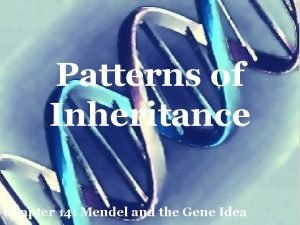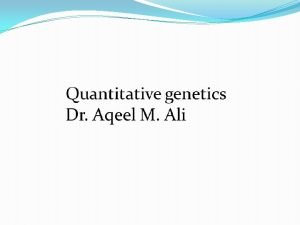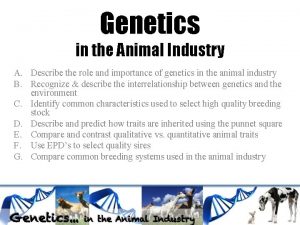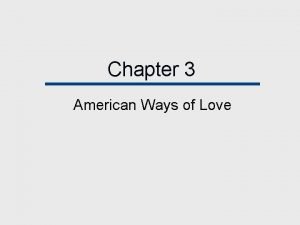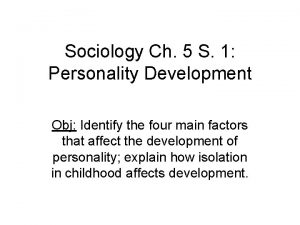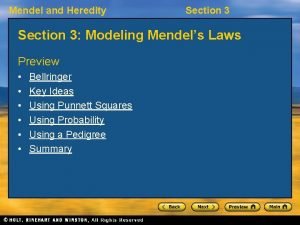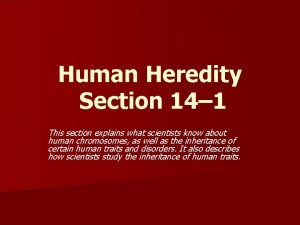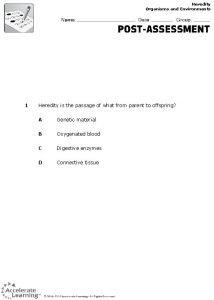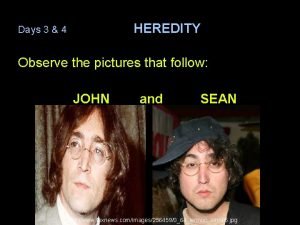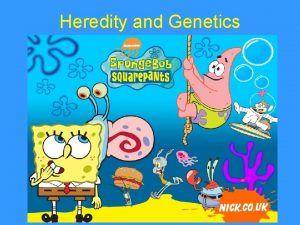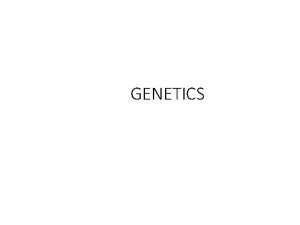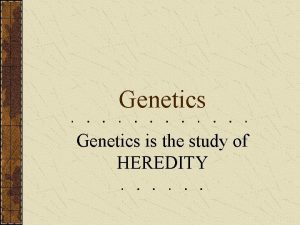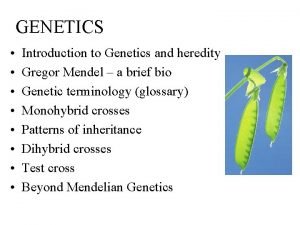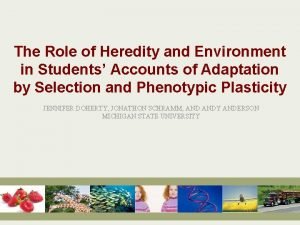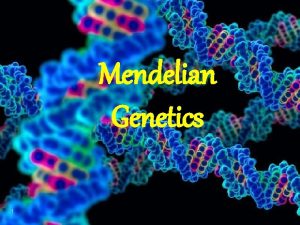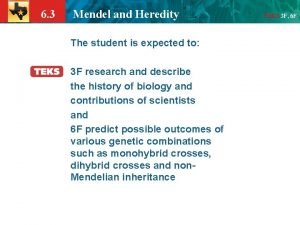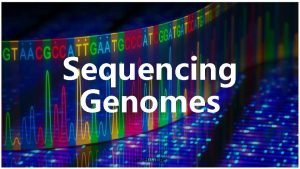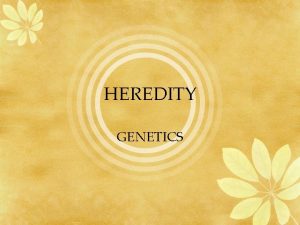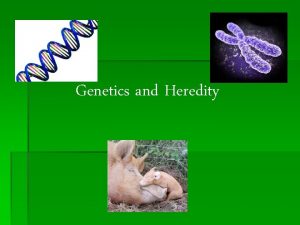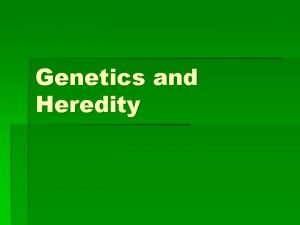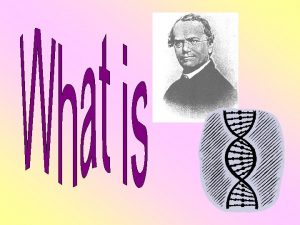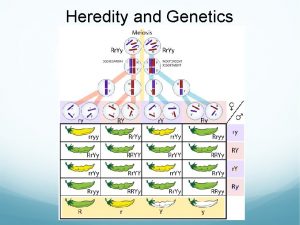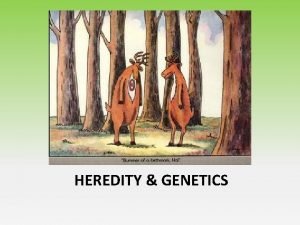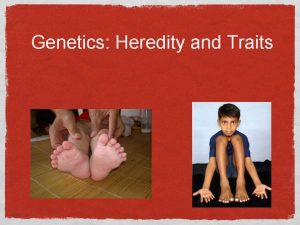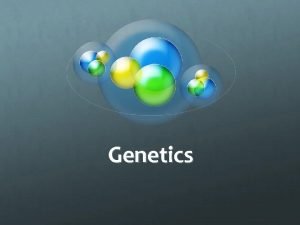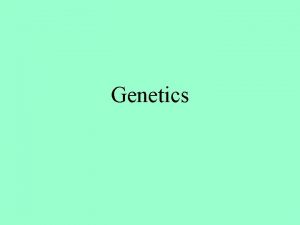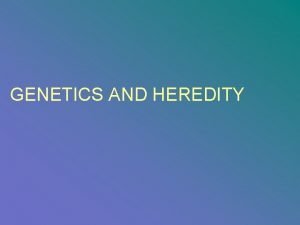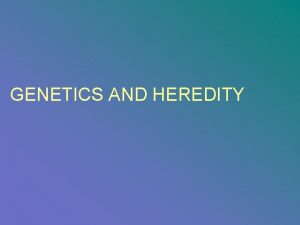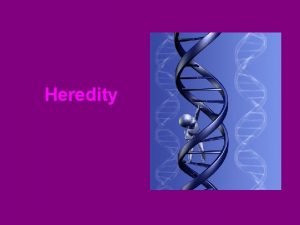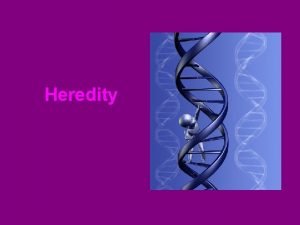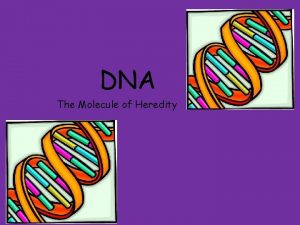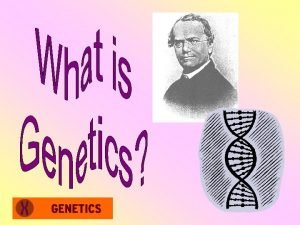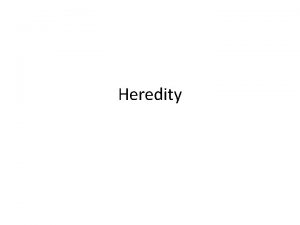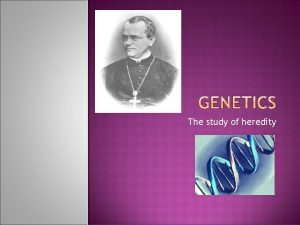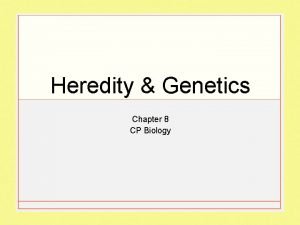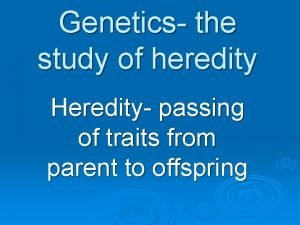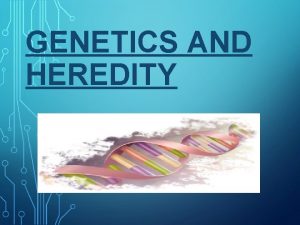Genetics Chapter 11 Heredity Passing of traits from



























- Slides: 27

Genetics Chapter 11

Heredity • Passing of traits from parent to offspring

Genetics • The study of heredity • Gregor Mendel. Austrian monk known as the “father of genetics”

Mendel’s Four Hypotheses 1. For each inherited trait, an individual has a copy of that gene from each parent. 2. There alternate versions of genes, called alleles. (ex: freckles or no freckles)

Hypothesis continued 3. When 2 different alleles occur together, one of them may be completely expressed (dominant), while the other may not be observed (recessive). 4. Alleles separate independently, so that each gamete only carries 1 allele for that trait.

Monohybrid cross • Mendel began with 1 trait (monohybrid) crosses • He bred pea plants to produce several generations P- the parent generation F 1 - the first filial generation F 2 - second filial generation


• Mendel concluded that each parent has two separate “factors” for a particular trait • “Factors” are now called genes.

Mendel’s Laws of Heredity 1. Law of Segregation- two alleles separate when gametes are formed 2. Law of Independent Assortment- alleles of different genes separate independently of one another during gamete formation

Homozygous dominant parent Homozygous recessive parent (chromosomes duplicated before meiosis) Mendel’s Law of Segregation meiosis II (gametes) fertilization produces heterozygous offspring Fig. 11 -5, p. 172

Nucleus of a diploid (2 n) reproductive cell with two pairs of homologous chromosomes Independent Assortment Possible alignments of the two homologous chromosomes during metaphase I of meiosis The resulting alignments at metaphase II Allelic combinations possible in gametes 1/4 AB 1/4 ab 1/4 Ab 1/4 a. B Fig. 11 -8, p. 174

Some modern genetic terms • Alleles are represented by letters – Dominant allele is a capital letter – Recessive allele is a lower case letter

• Homozygous- identical alleles for a specific trait (BB, FF, rr, tt) • Heterozygous- alleles are different for a specific trait (Bb, Ff, Rr, Tt) (aka “hybrid”) • Genotype- the set of alleles an individual inherits for a trait (i. e. - Rr, Ww, ff) • Phenotype- the physical expression of a trait (i. e. blue eyes, freckles, dimples)

Punnett Square • Predicts possible outcomes of traits • Shows all possible outcomes of a genetic cross

• Probability (likelihood that an event will occur) of a genetic outcome can be predicted • Ex: cross two heterozygous individuals Aa x Aa predict ratios of 3: 1 for phenotype and 1: 2: 1 for genotype

Practice • Curly hair is dominant over straight hair. A man with straight hair and a woman who is heterozygous for curly hair have a child. What is the probability that this child will have straight hair?

• Incomplete Dominance- when an individual shows a combination of the inherited alleles. Ex: red snapdragon x white snapdragon will produce a pink snapdragon straight hair x curly hair = wavy hair

• Codominance- 2 dominant alleles are expressed at the same time Ex: Roan horses show both red and white hairs in equal numbers

Patterns of heredity can be very complex • Sex-linked trait- a trait whose alleles is located on the X chromosome (most are recessive) • Polygenic trait- trait where several genes influence the outcome (eye color, hair color, skin color, height, weight)

• Multiple Alleles- genes with 3 or more alleles - Blood type is an example of multiple alleles because we have A, B and O alleles and 4 possible blood type outcomes (A, B, AB and O)

ABO Blood Type Range of genotypes: IAIA IBIB or or IAi Blood Types: A IAIB AB IBi ii B O Fig. 11 -10 a, p. 176

Diploid • Number of chromosomes found in the body or somatic cells of an organism • “ 2 n”

Haploid • Number of chromosomes found in the gametes of an organism • “n”

Meiosis • The type of cell division that produces gametes • Gametes = sex cells – female gamete = egg or ovum (plural = ova) – male gamete = sperm

Meiosis

Formation of sperm and egg

 Chapter 17 the beginning of the life cycle
Chapter 17 the beginning of the life cycle Genetics is the study of heredity and variation
Genetics is the study of heredity and variation Chapter 11 human heredity section 11-3
Chapter 11 human heredity section 11-3 Chapter 11 complex inheritance and human heredity test
Chapter 11 complex inheritance and human heredity test Extra x
Extra x Dice and coin
Dice and coin Quantitative and qualitative traits
Quantitative and qualitative traits Qualitative traits vs quantitative traits
Qualitative traits vs quantitative traits Qualitative traits vs quantitative traits
Qualitative traits vs quantitative traits Passing love chapter 3
Passing love chapter 3 Genetic vocabulary worksheet answer key
Genetic vocabulary worksheet answer key Heredity characteristics include body build
Heredity characteristics include body build Heredity concept map
Heredity concept map Section 3 mendel and heredity
Section 3 mendel and heredity 14-1 human heredity
14-1 human heredity Heredity defines the passage of genetic material from
Heredity defines the passage of genetic material from Pictures of heredity
Pictures of heredity Allele
Allele Genetics
Genetics ____________ is the study of heredity.
____________ is the study of heredity. Mendelian principles
Mendelian principles Unit 7 cell division and heredity
Unit 7 cell division and heredity Importance of heredity and environment in education
Importance of heredity and environment in education Section 3 mendel and heredity
Section 3 mendel and heredity When do alleles segregate during meiosis
When do alleles segregate during meiosis The basic units of heredity
The basic units of heredity Section 3 mendel and heredity
Section 3 mendel and heredity Sanger sequencing
Sanger sequencing





